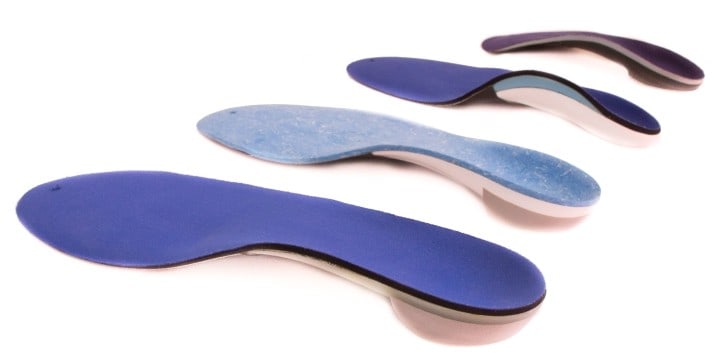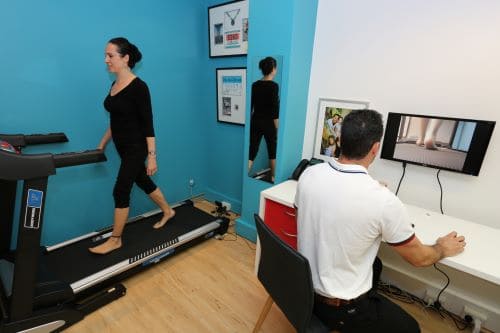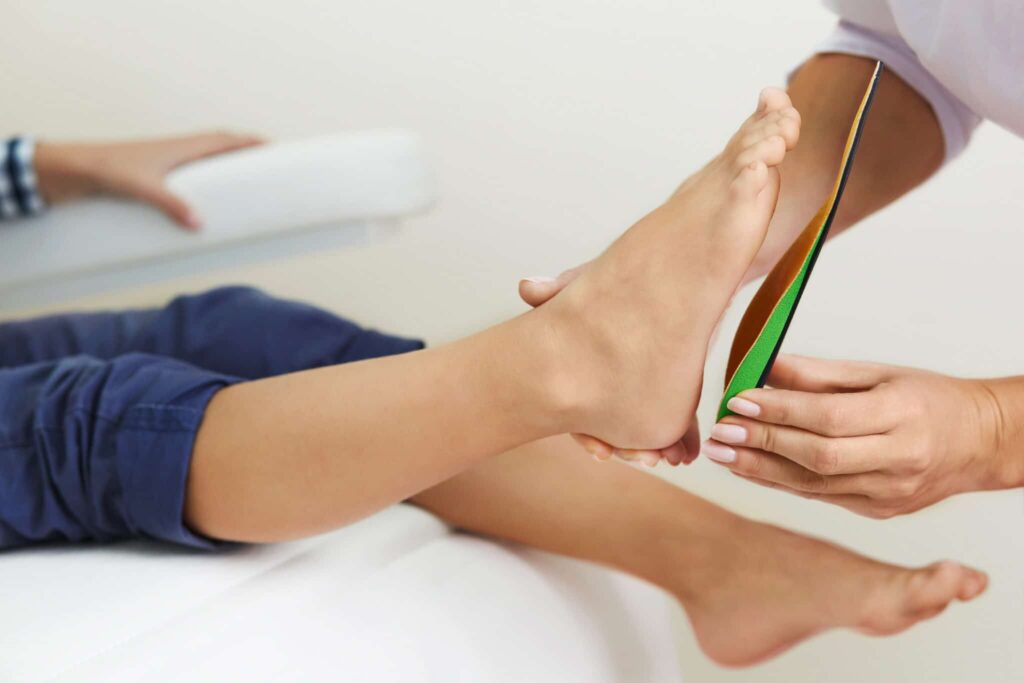At ModPod we have been prescribing Orthotics for over 20 years.

Conveniently
Located Clinic
5 Convenient Clinics Across Sydney & 2 Central Coast Clinics

EXPERIENCE
Treated Over 30,000 Patients

Expert Care
We Have A Wealth Of Knowledge With All Types Of Insoles

New Patient
Offer
New Patient Offer – $15 OFF First Visit
What Are Orthotics
These are devices used to support, align, or correct the function of the feet, ankles, and legs. Custom-made or prefabricated orthotics can be used to treat a variety of foot and ankle conditions. These include flat feet, high arches, and plantar fasciitis.
Custom orthotics are specially designed for each individual. They are created from a precise mold of the person’s foot. This ensures that the insoles fit the unique shape and needs of the person
Foot orthotics can be made from different materials including foam, plastic, or carbon fiber. They can be used to treat or prevent foot and ankle issues.
Prefabricated footbeds, on the other hand, are pre-made and come in a variety of sizes and shapes. They are less expensive than custom insoles but may not provide the same level of support and comfort.
Orthotics are a treatment option for many conditions. These include pain in the foot, ankle, knee, hip, and lower back. They can also be used to improve athletic performance and prevent injuries.

The use of footbeds dates back to ancient civilizations. In Egypt, sandals with arch supports were used around 2000 BC. These sandals were made from woven plant fibers.
They provided comfort and support to the feet. In Greece, around 400 BC, Hippocrates described the use of pads to relieve pressure on the feet.
In the Middle Ages, wooden shoes or pattens with raised heels were popular in Europe. This was to protect people from muddy and unsanitary streets. Later, in the 18th century, shoemakers began to incorporate metal or leather braces into shoes to correct deformities and provide support.
During World War I, the demand for shoe inserts increased as soldiers suffered from foot and leg injuries. Orthopedic surgeons developed new designs of braces, shoe inserts, and prosthetics to improve mobility and function.
In the 20th century, advancements in technology and materials led to the development of modern footbeds. Custom-made shoe inserts became more accessible. They are created with molds and computer-aided design. This allows for more precise and effective treatment of foot and ankle conditions.
Shoe inserts are today commonly used to address many issues. They come in a variety of styles and materials. Foot and ankle conditions often require orthotics as part of the treatment plan. Orthotics have been continually improving as new technologies and materials are developed.
Custom orthotics are specifically designed to fit an individual’s feet and provide support, correction, and relief for a variety of foot and ankle problems. They are made from a mold of the foot that is taken by a podiatrist.
The process of making custom orthotics typically involves the following steps:
Evaluation: A podiatrist will evaluate the individual’s feet, gait, and medical history to determine the best type of shoe insert for their needs.
Casting or scanning: A mold of the feet is taken using either plaster casting or digital scanning. This mold captures the unique shape and contours of the feet.
Design and fabrication: The mold is used to create a design, which is then fabricated using materials such as foam, plastic, or carbon fiber. The insole is shaped and trimmed to fit the individual’s feet.
Fitting: The insert is fitted into the individual’s shoes to ensure proper fit and comfort.
Custom orthotics are typically more expensive than prefabricated insoles, but they offer a higher level of customisation and precision. They can provide long-lasting relief and correction for foot and ankle problems, and are often covered by health insurance plans with a podiatrist prescription.
Prefabricated insoles, also known as off-the-shelf orthotics, are pre-made foot supports that are designed to provide a generic level of support and correction to the feet. They are typically made from a variety of materials, such as foam, gel, or plastic, and are available in a range of sizes and shapes.
Prefabricated insoles are generally less expensive than custom orthotics and can be purchased without a prescription. They are available over-the-counter at pharmacies and online retailers.
They are designed to provide relief for a variety of common foot and ankle conditions, such as plantar fasciitis, flat feet, and arch pain. They can also be used for general foot and arch support, as well as to prevent foot and ankle injuries during athletic activities.
While prefabricated insole are not as customised as custom orthotics, they are still effective for many individuals who require a basic level of foot support or correction. However, individuals with more severe or complex foot and ankle problems may benefit more from custom orthotics.
It is important to choose the correct size and type of prefabricated insole for your needs, and to consult with a podiatrist if you have questions or concerns about using your footbeds.
How Do Orthotics Work?


Orthotics work by modifying the forces between your foot and the ground. An orthotic is designed to enhance the motion of your foot. Depending on the type of orthotic and the individual’s specific needs, orthotics can help to:
- Improve alignment: Orthotics can help to correct abnormal foot and ankle alignment, which can reduce stress on the feet, ankles, knees, and hips.
- Reduce pain: Orthotics can help to redistribute pressure on the feet and reduce pain caused by conditions such as plantar fasciitis, flat feet, and heel spurs.
- Improve function: Orthotics can improve the function of the feet and ankles, allowing individuals to walk, run, and perform daily activities with greater ease and comfort.
- Prevent injuries: Orthotics can help to prevent foot and ankle injuries by providing support and stability to the feet during athletic activities or other high-impact movements.
The specific way that orthotics work depends on the type of orthotic and the individual’s needs. Custom orthotics are designed to provide a precise level of support and correction for the individual’s specific foot and ankle needs. Prefabricated orthotics provide a more generic level of support and correction, but can still be effective for many individuals who require basic foot support or correction.
Orthotics are typically worn inside the individual’s shoes and should be fitted properly to ensure maximum effectiveness. It is important to follow the recommendations of a podiatrist when using orthotics, as improper use or fit can lead to discomfort or further injury.
Our biomechanical assessment is a process of analysing the movement and function of the foot/leg and body, with a focus on the mechanical forces that are involved in those movements. The assessment may include a variety of tests and measurements to evaluate the range of motion, strength, and stability of different parts of the body. The assessment may also be used to identify biomechanical issues that may contribute to poor posture, gait abnormalities, and other movement-related problems. Based on the results of the assessment, a treatment plan may be developed that includes exercises, orthotics or other interventions to improve function and reduce pain.

Successful Treatments

Get Back To Activity Sooner

Evidence Based Approach

Walk Pain Free Again

You Are In Safe Hands
What Are The Common Conditions
We Treat With Orthotics
Orthotics are used to treat a wide variety of conditions and injuries affecting various parts of the body. Here are some of the most common conditions treated with orthotics:
Foot and ankle conditions: Orthotics are commonly used to treat conditions such as plantar fasciitis, flat feet, high arches, heel spurs, and Achilles tendonitis.
Knee and leg conditions: Orthotics can be used to treat conditions such as patellofemoral pain syndrome, shin splints, iliotibial band syndrome, and knee osteoarthritis.
Hip and lower back conditions: Orthotics can be used to treat conditions such as hip osteoarthritis, sacroiliac joint dysfunction, and lower back pain.
Sports injuries: Orthotics can be used to prevent and treat sports-related injuries such as stress fractures, ankle sprains, and turf toe.
Neurological conditions: Orthotics can be used to treat conditions such as cerebral palsy, multiple sclerosis, and stroke by providing support and control to affected limbs.
Overall, orthotics are a versatile and effective treatment option for a wide range of conditions and injuries affecting the musculoskeletal and nervous systems. They can help improve function, reduce pain, and prevent further damage or injury.

Would you like to have pain free feet again?
Book your first visit and get $15 OFF
Frequently
Asked Questions
Not everyone needs to be wearing orthotics. However if bad and abnormal forces are beyond your bodies’ current capacity to tolerate them then an orthotic may be of benefit. Tissue has a particular capacity to tolerate stress, a certain amount of stress is essential for positive adaptation however if placed beyond this level for an extended period of time or if done repeatedly some parts may begin to let you down.
If you are not sure about the need for an orthotic, give us a call and one of our Sydney orthotics experts can talk through this process with you.
No! Not if the orthotics are designed and used correctly. Current evidence has shown quite the opposite, that if you wear orthotics there is an increase in foot muscle activity.
Orthotics are not a life sentence!. The exact reason why you need an orthotic in the first place and the severity of your initial injury will dictate how long you will need to wear the orthotics for.
Wherever possible there will be a plan in place to remove the orthotic and allow your improved foot function to continue.
If you’re looking for the best Sydney orthotics on offer look no further than ModPod.
Orthotics can be worn with many types of shoes, but some shoes may be better suited to orthotics than others. It is important to choose shoes that provide enough space and support to accommodate the orthotics.
Many insurance plans will cover the cost of orthotics, but coverage varies by plan. It is important to check with your insurance provider to determine if orthotics are covered and what the out-of-pocket costs may be.
Orthotics may need to be replaced if they become worn, damaged, or no longer provide adequate support or alignment. It is important to have orthotics checked every 12 months by a podiatrist to ensure they are still providing the intended benefits.
Chronic pain: The persistent pain associated with Morton’s neuroma can make it difficult to walk, stand, or engage in physical activity, which can negatively impact your quality of life.
Foot deformities: Over time, Morton’s neuroma can cause the affected toes to become permanently contracted or misaligned, which can lead to other foot deformities.
Nerve damage: In some cases, Morton’s neuroma can cause permanent nerve damage, which can lead to numbness or tingling in the affected area.
Reduced mobility: If your Morton’s neuroma symptoms are severe enough, you may have difficulty walking or standing for extended periods of time, which can limit your mobility and independence.
It is important to seek treatment for Morton’s neuroma to prevent these potential complications from occurring.
$15 OFF First Visit
Please fill out the form to receive your $15 voucher.
Terms and Conditions
- Only valid to New Patients to ModPod.
- Not to be used in conjunction with any other offer
- Not to be used in conjunction with EPC programme
WESTFIELD KOTARA
- Level 1, Westfield Shopping Center (Next to Kotara General Medial Practice)
- (02) 4091 0465




